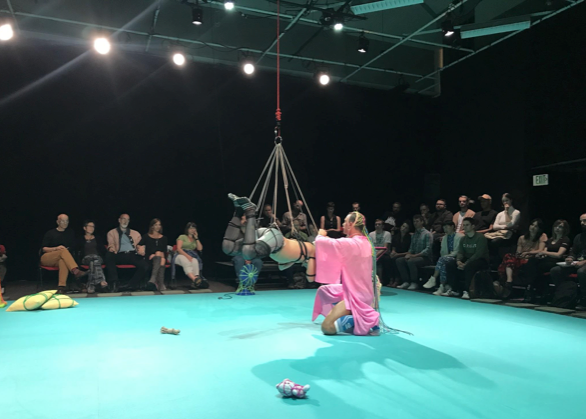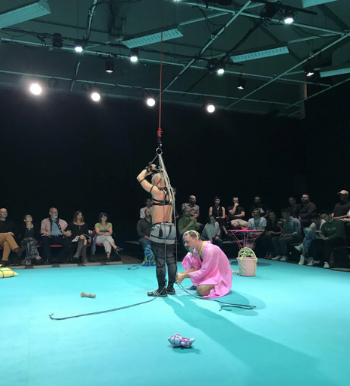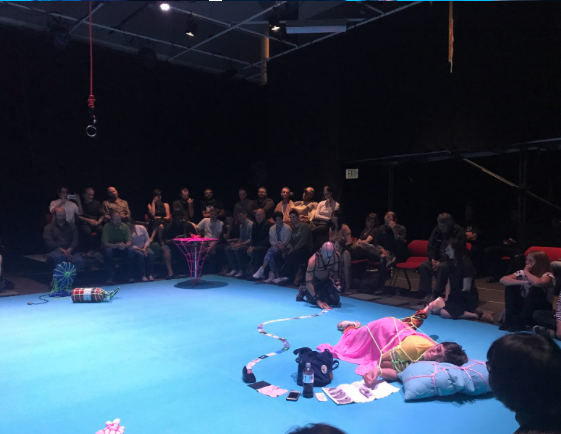The Binds That Tie: Bunny at T:BA 2017
Each fall, the Portland Institute for Contemporary Art hosts a ten-day immersive Time Based Art (T:BA) global festival held in Portland, Oregon, consisting of original performances by international and local artists. Along with performances that engage a wide-variety of mediums and musings, T:BA is a space for thought-provoking dialogues and conversations, compelling exhibitions, lively late-night music, screenings, workshops and more. This year’s festival occured from September 7-17 and themes broached by the artists and events ranged from self-reflection and expression, to engagement with current events, space and time, concepts of value, and reflections of our current culture. With its emphasis on time, in that T:BA exists only in the space of these ten days, its ephemeral presence is even more demanding of our attention. T:BA presents itself as “Art in Real Time.” Among the plethora of this years’ talent and performances at the festival, Bunny, performed by dance provocateurs Luke George and Daniel Kok, engages the crowd in an incredibly direct capacity, asking them to be active participants as opposed to the typically passive audience member.
Bunny derives its nomenclature from the practice of bondage art, of which both George and Kok are practitioners. The name “Bunny” is given to any individual or practitioner being tied in rope bondage. In this work, the two artists are questioning what it means to be a Bunny: what if each and every one of the audience members was also a Bunny? I noticed myself and every single other audience utterly engrossed in what is occurring; our attention was fully focused on what was happening on stage. Each performance is simultaneously the same and different, depending on the willingness of the audience to engage with the artists. An exploration of the present moment, Bunny is part dance and part music, part liberation and part mutual trust, part risk and part safety.
Viewers walk in while George is still setting up the stage and are confronted with their first choice of the evening, do they sit in chairs placed on the periphery or on mats lined along the inner edge of the stage. The brave choose the floor; brave only because choosing to sit on the ground, essentially on the stage, is as good as raising your hand and volunteering to participate in the act. In the center, George is putting the finishing touches on Kok’s knots -- his limbs, sternum, and even face are bound -- before he hoists Kok up off the ground and spins him. Kok’s body, now spinning in the air, glistens in the light and I can’t tell if it is sweat or glitter, but I decide it’s probably both.
The stage is bright blue and scattered about are various objects such as a stereo, pillows, a vacuum, a fire extinguisher, and of course, two fake bunnies, all tightly bound by rope. The performance has begun and George’s first order of business is to ask an audience member to, in turn, tie him up as well. Bunny is reciprocal, it grows and feeds off the energy created in the space, and this is only the beginning. The performance proceeds methodically and mostly silently, apart from George’s occasional grunting from moving across the mat or his instruction towards the audience. The first half is slow, but nonetheless enthralling.
After some movement across the mat by George and dialogue amongst the audience, he requests that Kok be released from his air-bound bond. Once on the ground, Kok begins to move about the mat carefully but expressively, his gestures calculated. Towards the middle of the performance, after George is released from his ropes as well, the two artists erupt in synchronized dance, with the music blaring and the lights flashing brightly and sharply about the room. This shift in the tone of the piece is jarring, but also somehow unsurprising -- their dance is just as provocative as their bondage, and they move with agility and grace, perfect foils of one another. Following this, they resume their engagement with the audience and begin to tie those that are willing to consent. It appears as if they have an internal method for choosing their bunnies -- watching George, I notice how carefully and cautiously he approaches someone. He stares deeply into his selected audience members face before smiling and asking, “It’s ok?” If they grant him permission, they succumb to George and Kok’s whims -- they are lead round the room, hoisted up, blindfolded, asked to lay down, and so forth. Regardless of the activity they are asked to engage in however, the first step in their involvement is to be bonded in a variety of intricate knots. Both artists bond quickly and with dexterity; there is no hesitation on their part, or the audience's for that matter, but there is a coyness, a mischievous playfulness that hangs in the air of the room. Everything is pristine and precise. Their actions are cautious but exploratory, and their ties, although they appear soft, are strong.
As inconspicuously as the performance started it ends and the audience is brought back into reality. George walks off the stage to sit on the floor as if he were part of the audience, as if to admire his own work. The lively neon lights used during the show are once again replaced with the bright stage fluorescents. In this light one can notice the fibers of rope that have split off from the tight knots and are now floating in the air, illuminated by the shine of the spotlight. George is still sitting and Kok turns to the audience and says thank you. The performance is over.
Like most performance art, the performers at T:BA grapple with concepts of the stage as an arena of action and the audience members as active agents in the space. In Bunny, Luke George and Daniel Kok push the boundaries of what it means to be in the act of viewing a piece of work, which is inherently a very intentional choice on the part of the audience member, bordering almost on the voyeuristic . Stemming from George’s own fascination with the intimacy generated between the performers and the audience, George and Kok question how this interaction happens in the small space of a performance hall, how this conversation is transmitted and ultimately to what means. The gesture being made here is a way to chart the thread of signification. “Bondage” here takes on a double meaning. First, in the literal ties that George and Kok are binding, and second, in the metaphorical ties that stitch audience and artists to the specific time and place of this performance. The type of consuming engagement that this show demands is rewarding -- one is obliged to be fully present and indulge in the dialogical expectations of the piece to reap its full benefit. Bunny is sexy; it is alluring and it is playful, defying both gravity and boundaries. As a result, one leaves the space fostering a bond and shared experience that had not existed prior to their entering the room.
For more on PICA and T:BA visit http://pica.org/programs/tba-festival/tba17/.
Images courtesy of Lusi Lukova.








